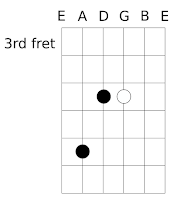Guitar Fundamentals: Major Triads I
Have you ever wondered how some guitarists can play any type of chord anywhere on the neck? In this lesson I'll show you how to do just that by teaching you to play some simple triad shapes. Learning how to find triads on the guitar will vastly improve your knowledge of the fretboard and allow you to go beyond simply playing open chords or barre chords, plus they are way easier to play!
What is a triad?
A triad is a three-note chord, typically made up of a root note, 3rd, and 5th. If you are unfamiliar with these terms, don't worry. It's not essential to know this in order to understand this lesson. Take a look at a C major triad on the top three strings (the thinnest three strings):
 |
| C Major Triad |
The white dot represents the root note, which is the note that we name the chord by. In this example, the white dot is on the 5th fret of the G string, which is the note C. This tells us that this is a C major triad. Like all shapes on the guitar fretboard, this shape is moveable up and down the neck, producing a major triad no matter where you move it to. With this shape, the name of the triad will always be the same as the name of the note on the G string.
If we take the top note (on the small E string) and move it down one octave to the same note on the D string, we end up with a new shape for our C major triad, this time on the D, G, and B strings:
 |
| move the top note down one octave |
 |
| C Major Triad |
Since we simply moved the top note down one octave, we haven't actually changed any of the note names, so this shape is still a C major triad. Also, just like the first example, this shape is named by the note on the G string, and can be moved up and down the neck to produce different major triads. If we wanted to play a D major triad, for example, we would find the note D on the G string (which happens to be the 7th fret) and play this shape.
Now if we take the top note of this shape (on the B string) and move it down one octave to the same note on the A string, we get another shape for our C major triad, this time on the A, D, and G strings:
 |
| move the top note down one octave |
 |
| C Major Triad |
Once again, all we've done here is move the top note down one octave, so none of the note names have changed. As you may have already guessed, this shape is also named by the note on the G string and is movable up and down the neck just like the other two examples.
One more time, we will take the top note of this shape (on the G string now) and move it down one octave to the same note on the E string, giving us the shape for a major triad on the E, A, and D strings:
 |
| move the top note down one octave |
 |
| C Major Triad |
Yet again all we've done is move the top note down one octave, so none of the note names have changed, meaning this is still a C major triad. This shape is movable in the same way as the other shapes, the only difference here is that this shape is named by the note on the E string.
Have a look at the resulting shape made from putting all the examples together, and compare it to the shapes we just learned:
The usefulness of these shapes comes from the fact they all contain the notes of a basic C major chord. You just learned four shapes for C major, and since they are all movable up and down the neck, you can use the same shapes for any major chord. There are 12 major chords, so in reality you just learned 48 new chords! All you have to do is line up the white dot with the note of the major chord you want to play, and you can use any one of these shapes OR any combination of these shapes in place of a C major chord, and it will still work!
For some examples of triads in real music, check out the following songs:
The guitar that starts playing at 7 seconds and continues until the first verse of "So Far Away" by Dire Straits:
The chords in the opening guitar riff of "Panama" by Van Halen:
There are two other sets of four major triads to learn which I will go over in the next installment of Guitar Fundamentals. Until then, play around with these shapes. Try them with different strumming patterns, play the full shapes, pick individual notes of the shapes to make a melody, try replacing the major chords in a song you already know how to play with any of these shapes. Make some music!
Don't hesitate to leave a comment if you are stuck or have a question. I will answer as soon as I can!






Comments
Post a Comment
Feel free to ask questions or start a discussion, or leave a suggestion for future articles! Please keep it civil.